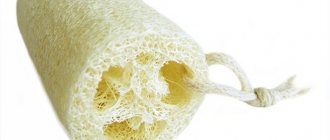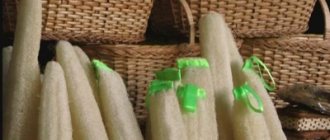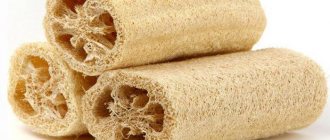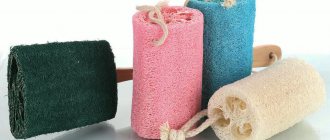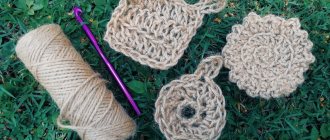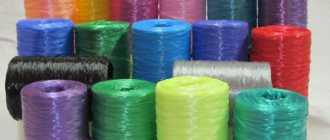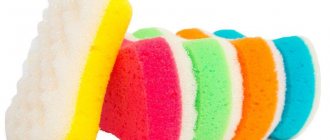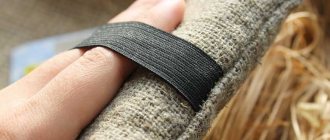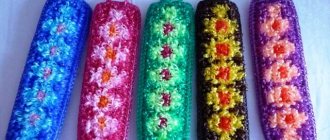Throughout my childhood I washed myself with a natural loofah washcloth! The most interesting thing about this is that I had no idea that it was a loofah! Its interesting shape, fibrous, porous structure did not in any way lead me to believe that it was a dried fruit!
Having grown up, I wondered where the raw materials for this natural washcloth come from... My surprise knew no bounds, honestly! So what is a loofah?
In common parlance, it is customary to write the word loofah with one letter f. However, the name is correctly spelled with two letters f, that is, luffa!
What is luffa
Luffa is an annual plant from the genus of herbaceous vines. It belongs to the pumpkin family, although in appearance it is very similar to a huge cucumber!
Among the people, luffa received a funny nickname - mad cucumber. The size of the fruit can reach up to 50-70 cm, weight from two to three kilograms, and the vine itself has a length of 3 to 6 meters. When dried, the weight of the fruit decreases significantly.
Luffa prefers tropical and subtropical climates, but it also grows in warm regions. Many amateur summer residents successfully cultivate and grow luffa. The plant is whimsical and has its own “requests”. With proper care, attention and care, as well as good climatic conditions on fertile soil, you can get more than three fruits from one bush!
Wise departure for a worthwhile purpose
Experienced gardeners advise growing luffa in such a way as to obtain large fruits. The first rule is to control the growth of the culture. When it reaches 4 m in height, its main shoot is pinched. Thanks to this, new ovaries will not form. And from those that already exist, large fruits will grow. The second rule is timely watering as the top layer of soil dries.
Thanks to a wise approach to business, gardeners successfully grow luffa in the Moscow region under a film or in a garden bed during hot times. A loose substrate is prepared in the traditional way. Disinfect it over steam or in the oven. Treat planting material with potassium permanganate or a growth stimulator. Wash with water. Wrap it in a wet cloth and wait for miniature sprouts to appear. Then one grain is placed in each pot. The seedlings are transferred to the greenhouse in mid-May. If the summer is hot in the Moscow region, then the crop is planted in the garden in mid-June. They are cared for according to the generally accepted scheme established by agronomists. Ripe fruits are harvested in September. If desired, make natural washcloths.
We carefully looked at how to grow luffa at home and get a useful product. The plant is used as an exotic ingredient for gourmet dishes. Its ripe pulp is used to make high-quality washcloths. With careful adherence to the rules of growing crops, a unique fruit with a dual purpose is obtained.
Varieties of luffa
There are more than 50 species of luffa, but only two types of plants have become widespread. Other types of plants produce too small fruits and require quite a lot of care. Therefore, it makes no sense to grow them
- Luffa ribbed
The young fruits of the ribbed luffa are used for cooking. It is stewed, boiled, and added to other dishes. It can be eaten raw and even canned. The pulp of young shoots is juicy and sweetish (very similar to the taste of cucumber).
But when the time comes for the fruit to ripen, the pulp turns into dry fiber. When the fruit dries completely, a sponge of woven dry fibers forms inside. It is taken from the dried fruit and used to make washcloths, rugs, mattress filling, and even to make hats. Filters for insulation are made from pressed luffa sponge.
- Luffa cylindrical (or Egyptian)
This species produces smooth, cylindrical or club-shaped fruits. This plant is often called loofah luffa. However, cylindrical luffa can be used not only for making washcloths.
The scope of its application is the same as that of the sharp-ribbed relatives. But, most often, natural washcloths are made from it. This species has tender and juicy pulp, delicate and thin skin that is easy to peel from dry fruit.
Dishwashing sponge
If you need washcloths for washing dishes, I just cut them into pieces. For such washcloths, I choose the hardest, well-ripened luffa, like this:
They lather soap and detergents well, and clean no worse than a foam sponge. Then it is enough to rinse it well, and when it dries, it takes on its original appearance. It just turns out to be much more environmentally friendly, since by throwing away a used sponge, we pollute the environment, and a loofah sponge will completely rot.
How to make a loofah from luffa fruit
In order to turn a huge fruit into a wonderful bath attribute, you need to know some subtleties.
Only from ripe fruits can you make a sponge, that is, the pulp inside must dry. The color of the fruit will help you find out the exact time; when it turns brown, the time has come! And, of course, don’t forget about the dry tip at the end.
If the fruits have not had time to ripen (for example, you are unlucky with the weather), then they can be collected green and dried in a warm, dry room.
In order to obtain the skeleton of a loofah without much difficulty, you must first work with the fruit. Some summer residents recommend soaking the luffa skin for several days in water to soften it. But, there is a more practical way:
Dip the dry fruit in boiling water for 10-15 minutes, then cool and the skin is easy to peel. Once you get your future loofah, hold the fibers up to the light. Surprisingly many seeds, right!?
You also need to get rid of the seeds; this can be done in two ways - picking them out or putting a washcloth in water. The seeds should come out of the fibers on their own.
Once you have a real luffa sponge in your hands, rinse it in a soapy solution, then in clean water and let it dry in free air. Now it's time for your imagination! You can cover the luffa with soft fabric, cut it into convenient pieces, make double-sided washcloths - in general, whatever you want!
Advantages and disadvantages of natural washcloths
Manufacturers offer us a large selection of a wide variety of natural washcloths, which differ in shape, size, material density, and structure. Some people make eco-scrubbers with their own hands. I, too, recently had this desire: I have jute at home, and I know how to knit)). But so far this has not come to fruition.
Why should you choose natural washcloths for your hygiene, what advantages do they have over synthetic ones:
- Act as an antiseptic
- Massage the skin, increase its tone
- Improve blood circulation
- Cleanses pores
- Do not cause allergies
- Freely pass air
- Smell good
- Pleasant to the touch
- Environmentally friendly: decomposes when disposed of
Eco-scrubbers, when used and cared for correctly, will help you say goodbye to visible skin problems and improve the appearance of your body. They will help you cheer up in the early morning and relax after a hard day.
At the same time, such products are difficult to maintain and in some respects are inferior to their artificial counterparts, namely:
- They don’t release water well and take a long time to dry.
- Harmful microorganisms quickly develop in them
- Short-lived (average service life is two to three months)
- Most materials are hard to the touch
- Most often they foam poorly
- More expensive than synthetic analogues
Such a list of disadvantages can be intimidating, but in fact the advantages outweigh, don’t they?
How does a luffa washcloth work on your skin?
Any natural washcloth is hard and luffa is no exception to this rule. The fiber dried, hardened and became a rigid material. Not sissies like to wash themselves with such a washcloth. Who wants to enjoy an excellent skin massage in addition to washing - this washcloth is just for you!
An excellent massage effect, deep cleansing of pores, natural peeling of the skin and maintaining its tone - this is what a loofah can offer you. Although this washcloth is particularly hard, it has a softer effect on steamed skin in a bath.
After washing, the skin becomes elastic and toned. When it comes to preventing the formation of cellulite, a loofah made from luffa ranks first!
Loofah - edible healing sponge
24.02.2020
Despite the fact that eco-friendly washcloths are often made from loofah, many in our country are not familiar with this plant. Although it is exotic, it grows well here too. Once you grow a loofah and add it to your diet, testing it as a cosmetic, medicinal and handy home remedy, you will not remain indifferent to it. Moreover, this plant is not very whimsical.
The name “loofah” is given to a whole galaxy of herbaceous tropical vines from the Pumpkin family. In nature, there are more than 50 varieties of this plant, but only two of them are used for domestic needs - sharp-ribbed and cylindrical. All the rest grow too small and do not have the necessary physical characteristics for which large fruits are valued.
Externally, luffa (luffa, luffa) resembles its close “relatives” - zucchini and cucumber.
The ribbed loofah is grown mainly for its fruits, which, when unripe, are used like ordinary cucumbers in salads, soups, side dishes and other dishes. The fruits are long, from 30 cm or more, the pulp of the greens is starchy and tasty. Loofah contains 1.5 times more carotene than sweet peppers and carrots. It is also grown for its seeds, which contain about 50 percent edible oil. But the oil obtained from cylindrical loofah is poisonous, not suitable for food and is used only as a medicine.
The fruits of the cylindrical (loofah) loofah are also edible at a young age, but by the end of summer they become woody, dry out and are used to make washcloths, various decorative crafts and other household items.
Ribbed luffa | Cylindrical luffa |
When grown in our conditions, the harvest can be 7-12 young fruits weighing 2-3 kg. As they ripen, they lose moisture and their weight decreases.
This vine is native to the subtropical and tropical regions of Asia and Africa. It is grown commercially today in China, Japan, Indonesia, the Philippines, Hong Kong, Brazil and the Caribbean. You can successfully grow loofah on an industrial scale in the south of the Caucasus, in the Krasnodar Territory and in the Crimea.
This amazing plant can be a real decoration of the garden - it looks elegant throughout the entire growing season.
Loofah can be eaten, used to treat certain diseases, used as bath accessories and cosmetics, and can also be used to make stylish, eco-friendly interior items.
Even before the middle of the last century, technical parts were produced from the ripe fruits of the cylindrical loofah - filters, seals for mechanisms, etc. Now they have been replaced by synthetic materials...
What are the benefits of luffa?
The leaves of this plant contain a lot of carotene, vitamin C, iron and protein. It can be an excellent source of polyunsaturated fatty acids, phosphorus, calcium, magnesium, zinc, vitamins A, B and C.
The leaves, fruits, and seeds of the plant are a folk remedy for many diseases. In eastern countries, a decoction is prescribed for eczema, dermatitis, dropsy, leprosy, and hemorrhoids. In Africa, the juice of the leaves is used to treat conjunctivitis. By drinking the juice orally they fight jaundice, and by rubbing it they treat wounds and ulcers. Loofah is useful for anemia, bronchopulmonary, joint diseases, and helps young mothers increase lactation.
Loofah dressings (designed by Mauricio Afonso) are a better alternative to plaster.
What can you make from loofah?
Unripe loofah fruits have a delicate, pleasant taste that is similar to the taste of zucchini and cucumber.
Young loofah fruits, 10-20 centimeters long, are eaten as long as they retain their delicate taste and aroma, as well as shoots, leaves, buds and flowers. The green mass is stewed and served as a side dish. The shoots and buds are good in salads.
The juice of young leaves has a peculiar bitter-musky taste.
The tender green loofah fruits are eaten raw, boiled, stewed, fried, stuffed and pickled. Place in soups, stews, salads, stew with mushrooms or beans. Fruit pulp is added to omelettes.
The seeds, similar to watermelon, can be roasted and eaten as sunflower seeds.
Loofah goes well with olive oil, soy sauce, garlic, pepper, ginger, cumin, as well as legumes, seafood, rice and rice noodles.
For storage, luffa fruits are washed, peeled, cut and frozen. Young fruits are cut into slices and dried.
Loofah loofah
This plant sponge does not cause allergies, and at the same time as washing it provides a good massage of the skin and muscles of the body. Due to its rigidity, it has a peeling effect. After washing your skin with such a washcloth, it becomes as soft as a child’s.
At the same time, you need to know that the degree of hardness of a loofah depends on its maturity - the more mature the plant is, the harder its pulp will be. Its age is visually determined using the size of the washcloth itself and the size of its cells. The larger they are, the rougher the loofah. Sometimes dark seeds can be found in the mesh mass. They are also an indicator of maturity, and therefore toughness. These washcloths should not be used by people with sensitive skin.
After each use, the vegetable sponge should be thoroughly washed with soap, preferably with laundry soap, and dried on a radiator.
How to make an eco-loofah sponge?
Quite simple. To do this, the ripe fruits need to be dried a little. When the seeds begin to make noise when shaken, the ends of the fruit need to be cut off and the peel carefully removed. Next, the loofah is poured with boiling water, wrapped and left for 15-20 minutes. You can also boil the prepared fruits for 15 minutes in a soap solution. Then the loofah is cooled, the seeds are shaken out, the remaining peel is removed, washed, dried and decorated in the form of a washcloth.
Fruits processed in this way are also used as insoles for shoes and linings for hats.
The loofah is also used to make scrub soap. This soap opens pores, facilitates skin breathing, and stimulates blood and lymph circulation.
How to make soap with loofah?
In a water bath, without bringing to a boil, melt baby soap or soap base with the addition of a small amount of water. If desired, add vegetable dye (beet juice, onion peel decoction, St. John's wort or other natural dyes), essential oils for flavoring, as well as base oils: peach, almond, olive or any other.
Mix the mixture thoroughly. Place the prepared loofah into a suitable cylindrical container and fill with soap mixture. When the soap has cooled, remove it from the container and cut into pieces.
In addition, the loofah is suitable for makeup removing sponges and sponges. Apply cleanser to a dampened sponge and wipe your face in a circular motion, then rinse with warm water.
And from the young stems and leaves of the loofah, you can prepare a skin-whitening lotion. Just squeeze out the juice and wipe your face and hands with it.
Design ideas with loofah
Thermos and mugs with loofah inserts. They are comfortable to hold in your hands without the risk of getting burned:
Original lampshade made of loofah. When heated by a lamp, it does not emit unpleasant odors, unlike synthetic materials:
Acoustic loofah wall tiles provide excellent sound insulation:
Cute bath slippers:
Interior toys made from loofah:
Dental toys for animals are gaining popularity in Japan.
How to grow loofah loofah?
Since loofah is a heat-loving plant and has a long growing season, it is best to grow it in seedlings or in a greenhouse.
If you want to grow a loofah with long fruits, then the seeds for seedlings should be sown already in January, since the loofah needs a long photoperiod and an elevated temperature of up to 25 degrees Celsius. For the sake of growing only edible fruits, seeds of both types of loofah can be sown as seedlings in early April.
Growing loofah seedlings is a complex process. Its seeds are very hard, covered with a thick shell and require heating for a whole week at a temperature of about 40 degrees before sowing. They must be sown sprouted in pots with a diameter of 4x4 cm, and after two weeks the seedlings are transplanted with a lump of earth into larger containers with a diameter of 8-10 cm. After 20-25 days, another transplant, this time into pots with a diameter of 13-15 cm, in which the seedlings remain until planted in the ground in a permanent place. For planting in open ground, choose warm, sunny and windless areas of the garden. And don’t forget to provide a good support for the vine.
Already 10 days after the final transplantation, young lufina cucumbers can be used for food.
By mid-August, the fruits of the cylindrical loofah begin to coarse and become tough. At the stage of technical ripeness, they are only suitable for washcloths. To obtain longer sponges, the side shoots are pinched, and 9-10 fruits are left on the main stem. If the loofah does not grow in a greenhouse, then in August it is advisable to cover it with film. This accelerates the formation of a dense network of fibers. By the end of the season, they form a strong frame from which the washcloth is made.
By this time, loofah fruits can grow up to 1 meter in length. They turn yellow-brown and become so dry that the seeds begin to rattle when the fruit is shaken, and easily spill out through the hole made at the end of the fruit.
If you provide the loofah with the proper conditions, you can get up to 12 large fruits from one plant. When they ripen, they dry out and decrease in size. You should remove washcloths with the onset of cold nights, when the temperature drops below +10C. At the same time, you can cut even unripe fruits - they will “reach” in the room or on the windowsill.
Growing loofah from seeds is a painstaking but exciting task.
By planting this exotic plant on your property, you will provide yourself and your loved ones with a natural hygiene product, a tasty food product and valuable medicine, as well as an excellent material for decorative interior work and creative crafts. It is also important that loofah is one of the few cheap environmentally friendly materials that is fully recyclable. Draw the rest of your conclusions yourself.
© Methodical
Other articles on the topic "Sanity"
If you want to always learn about new publications on the site in a timely manner, then subscribe to our newsletter.
How to make a washcloth soft
Not everyone is a fan of harsh effects on the skin. But, since everything natural in itself is very useful for us, you can make a gentle and pleasant sponge for the body from hard luffa.
Children, older people and those who want to maintain their beautiful summer tan for as long as possible love to wash themselves with a soft washcloth. There is still a way out of the “hard” situation.
To make a washcloth soft, brew it with boiling water, cover with a lid and let it “simmer” for 10-15 minutes. That’s basically the whole procedure, the washcloth will become softer and can be used to wash sensitive and delicate skin.
In the bathhouse kingdom everything is much simpler! Father himself, the heat and steam of the bath softens the hard fiber. That’s why I wasn’t afraid of this hard washcloth as a child, the bath itself made it soft.
Of course, there is another way to make a washcloth soft. It is made double-sided, that is, on one side a soft fabric or sponge is sewn onto the luffa. You can also place the sponge inside the skeleton of the luffa, this will give twice as much soap suds, which will naturally reduce the hardness of the washcloth.
What if my loofahs are not ripe?
Maybe you didn't plant them early enough, maybe the frost comes sooner than you expected, maybe you ignored the frost warning but now it's snowing (oops). Regardless of the reason, the sponges you've worked so hard on may be picked before they're ready.
Don't panic yet!
You can still use them - it will take a little more work.
Here's how to dry a loofah that's too green.
- Peel and wash unripe squash in the same way as mature squash. Just know that cleaning immature sponges is more difficult and much messier because they will still be wet and juicy inside.
- Wash the opened sponge thoroughly, making sure there is no fruit juice left inside.
- Use the same cleaning recommendations given previously to achieve the desired cleanliness and color.
- When you are satisfied with the sponges, place them on a towel to dry, somewhere nice and warm.
It will take longer to dry indoors, and these sponges may not be as big or beautiful as your mature ones, but they will still be useful.
How to care for a loofah
The problem with all natural washcloths is that too many different bacteria and microbes like to make their permanent home in them. Here is another proof that all living things in the world love natural things!
However, if you want to use a loofah sponge for as long as possible, you cannot allow “tenants” into its porous structure. They will simply eat your washcloth, the fibers will spread, it will become frayed and torn.
That is, you definitely need to take care of your washcloth! After use, rinse it thoroughly, pour boiling water over it and be sure to dry it! In the bathhouse, the drying process happens somehow by itself - the kingdom is hot, the queen of the oven rules the show and dries everything!
But in an apartment, in a wet bath, the service life of a washcloth is significantly reduced. You can try drying it on a hot radiator in winter, and in open air in summer (for example, on a balcony).
This is my story about a natural loofah made from luffa. Of course, no two people are the same; everyone has different tastes and preferences. But this washcloth has taken root in our family for so long that I recommend that you get to know it. I think you won't be disappointed!
Agricultural technology for wet production
The famous money-grubber, Father Fyodor Vostrikov from the immortal work “The Twelve Chairs,” dreamed of a candle factory near Samara, which would help him spend the rest of his days in prosperity and luxury in his own house with servants. Who knows, maybe for someone opening their own basting production will be the beginning of the path to great success.
The key advantage of this plant is that its well-ripened fruits make excellent natural washcloths. They gently and delicately cleanse the skin of keratinized epidermis, relieve inflammatory processes on the surface of the skin, and are an absolute hypoallergen. In general, the use of such a washcloth is a kind of symbiosis of a soft scrub and a delicate superficial massage.
The technology for growing this plant is similar to the methods of agricultural technology for melons, in particular cucumbers. For planting, it is necessary to allocate well-drained fertile areas illuminated by the sun. Trellis should be recognized as a rational method of placement. It is in this way that it will be possible to achieve uniform illumination of plants and avoid thickening, in which the level of fruiting is reduced to 30%, and the fruits become smaller by almost half. By the way, about productivity. On 1 acre you can rationally place 30 plants, from the fruits of which you can make about 900 washcloths. Considering the cost of one washcloth in a retail chain, you can fairly accurately predict expected income. The main agricultural practices are as follows:
- One of the zoned varieties for the southern regions of the country should be recognized as the “Cylindrical” variety;
- Direct sowing of seeds into the soil is associated with the risk of late frosts, so preference should be given to growing through seedlings. It is sown in peat pots in March and the ambient temperature is maintained within 24-28 degrees Celsius. The seedlings are watered abundantly, not forgetting that air humidity for pumpkin plants is a very important factor for the successful growth and proper development of seedlings;
- When the first natural leaf appears, the temperature is reduced by 3 degrees Celsius;
- Seedlings at 6 weeks of age can be hardened off;
- Planting is carried out in southern, well-lit areas, when the danger of night and morning frosts has passed;
- Due to the shallow root system of this plant, you should immediately take care of the presence of support for the stem;
- The distance between adjacent roots should be at least 150 - 170 cm;
- When the central stem reaches a length of 500 cm, it must be pinched and thereby provoke the development of lateral shoots and increase the yield;
- During the growing season, young shoots and leaves can be removed without creating zones of local thickening.
Attention! Young leaves and shoots should not be thrown away as they are an excellent base for an effective skin care product. The green mass is finely chopped, 100 g. leaves and shoots add 5 drops of unrefined olive oil, 10 g. flower honey. The mass mixes well and is applied to the skin for 10 minutes, after which it is washed off with warm water.
For clarity and understanding of the principles of basic agrotechnical practices, we will form them in the form of a table:
| Name of agrotechnical technique or operation | Its general characteristics |
| Growing and forming a central shoot | No more than 500 cm. The crown is pinched in the classic way |
| Growing and forming side shoots | Shoots from the axils of 5-6 leaves are left 50-70 cm long and pinched. Shoots from the axils of subsequent leaves are left 80-100 cm long and pinched. |
The final ripening of the fruit begins in the first ten days of October and lasts until the end of the month. Harvesting and using fruits for making washcloths has its own subtleties.
Bast from a tree - do it from the beginning
Our loofah is ripe, how to make a washcloth? If you need a soft and tender washcloth, then the fruit must be removed approximately 7-10 days before full ripening and placed to dry in a well-ventilated area, away from direct sunlight. If the goal is to obtain a more rigid product and, accordingly, more durable, then it is worth waiting for final ripening directly on the plant’s vine.
Important! Fruit harvesting must be completed before the onset of autumn frosts.
Drying of fruits is carried out within 5-15 days, depending on specific conditions; the rustling of seeds in the seed pods can be considered a signal that the fruit is ready for further use, if you shake the fruit well. The most important process is removing the skin from the fruit.
Experts are divided into two stable camps, adherents of boiling and supporters of soaking. Let's consider both methods:
- The dried fruit is soaked in warm water for 1.5 - 2 hours, after which the skin is removed by making several shallow cuts along the entire length of the fruit.
- The dried fruit is soaked in cold water for 15-20 minutes, then placed in boiling water for 10-12 minutes, boiled and removed, placed in cold water for 2-3 minutes until it cools. The peel is removed with a stocking, through a single shallow incision made along the length of the fruit.
A word from Experienced! A good tool for making cuts in the fetus is a utility knife. It has a sharp blade and allows good control over the depth of the cut.
To be fair, it is worth noting that there is also a third camp. Its adherents remove the skin and seeds from the dry fruit without soaking or boiling. But this, as they say in Odessa, is “purely for the true amateur.”
The pulp, cleared of skin and seeds, is trimmed at the ends, washed in a saturated solution of laundry soap and dried. Now the raw material can be molded into a future washcloth. Here the field for flight of imagination is truly limitless. Some people limit themselves to a classic rectangular-shaped washcloth with ribbons for holding, some make a mitten for massage, others make a washcloth in the form of intricate geometric shapes or animals.
The use of plant-based washcloths
The use of washcloths made from natural raw materials involves several points:
- Before use, soak such a washcloth in warm water for 3-5 minutes.
- You can use the product no more than 2 times a week.
- The total service life of such washcloths, subject to storage conditions, can be 2-3 months.
- Store well dried in a cool, dry place, away from direct sunlight.
The overall service life of this type of sponge directly depends on the quality and strength of the plant fibers that form the basis of the fruit. In addition, it should be remembered that the older the fruit is, the more fully it has ripened in natural conditions, directly on the plant’s vine, the longer it will last. True, although such washcloths are more durable, they are also rougher to use.

